The internet is in ruins. I mean, literally: data centers occupy abandoned military bases. We can trace a path from submerged Geocities to Google Smart City; from Amazon Fires (that read over our shoulder) to fires in the Amazon (fanned by streaming’s massive carbon footprint). Whatever it is that we have now, it’s sure a long, long way from the liberating network dreamed up throughout the 90s.
Transmediale 2020 takes the end of this dream as its starting point, summed up by theorist Ulises Ali Mejias on day one of the symposium: “If the network was the answer, what was the question? Was it the right answer?” After four marathon days of talks, shows, films and workshops, here’s what I’m thinking: if the internet (and the planet it spans) is in ruins, then whose ruins do we inhabit, how do we grow through them, and what do we want to grow?
Olia Lianina begins her performance lecture end-to-end, p2p, my to me by excavating the internet. She unearths a salvaged corner of Geocities, the web’s early homesteads, forever under construction. She hones in on spooky-themed sites awash with skeleton gifs, enter if you dare in Cool Flaming Text, MIDI music hollowly soundtracking these ‘realms’, ‘dungeons’, ‘worlds’. We are the ones who are being haunted though, by the now-defunct futures of the internet as a fun, open, place everyone could make their own.
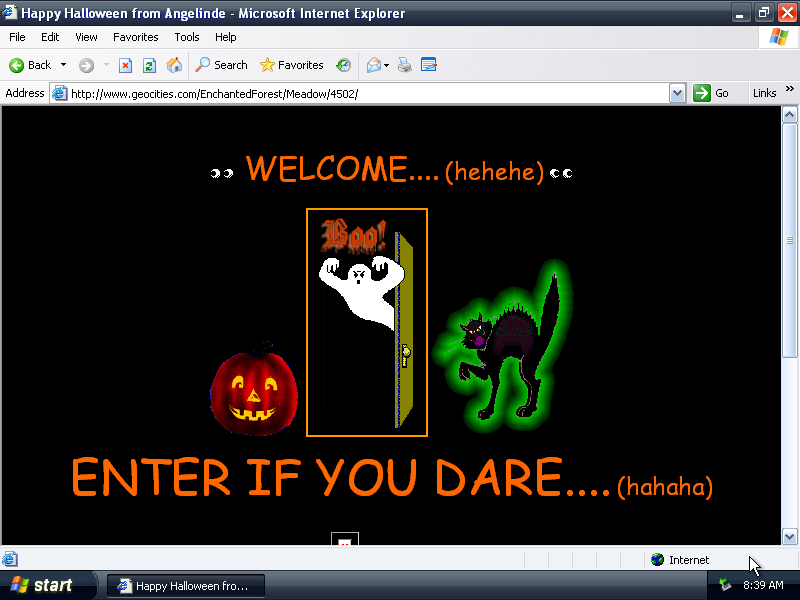
Image: One Terabyte of Kilobyte Age
Lialina charts a series of trajectories in the internet’s stylistic norms: from ‘my’ to ‘me; from ‘Welcome to my realm!’ to plain old ‘About Me’; from hyperlinks galore to the spartan content grids of Facebook that embalm us today, targeted ads infinitum. “Me is data. Me is metadata. Me is perfect for being advertised to.” She asked if — from the perspective of a bleak online future — we’ll ever look back on the heady days of platforms like Instagram, to a time when we could upload our own images, choose who we follow and even host a link. It’s funny, but also not. The trajectory of dominant social media platforms seems to be one of dispossession: the slow, creeping erosion of flexibility and privacy, the gradual standardisation and smoothing out of online public space. In light of this logic of dispossession, what kind of space will stand on the ruins of Instagram as it is today?
Another kind of ruins is being dreamed up in Norway. In an exchange titled Empires and Ecologies of the Cloud, environmental media scholar Mél Hogan brings up an image of a proposed data center in Norway designed to look like the retreating glaciers around it. It’s hard to think of a better parable for the anthropocene than these “data center imaginaries,” developments seeking to replace the geology we’re melting with storehouses to contain our datafied selves. The location was chosen for the abundance of cold water around it in order to cut costs on keeping the servers cool (one of the largest expenses in data centre operation). But as Hogan points out, suitability of environment can just as easily mean vulnerability: cold places are more fragile to heat.
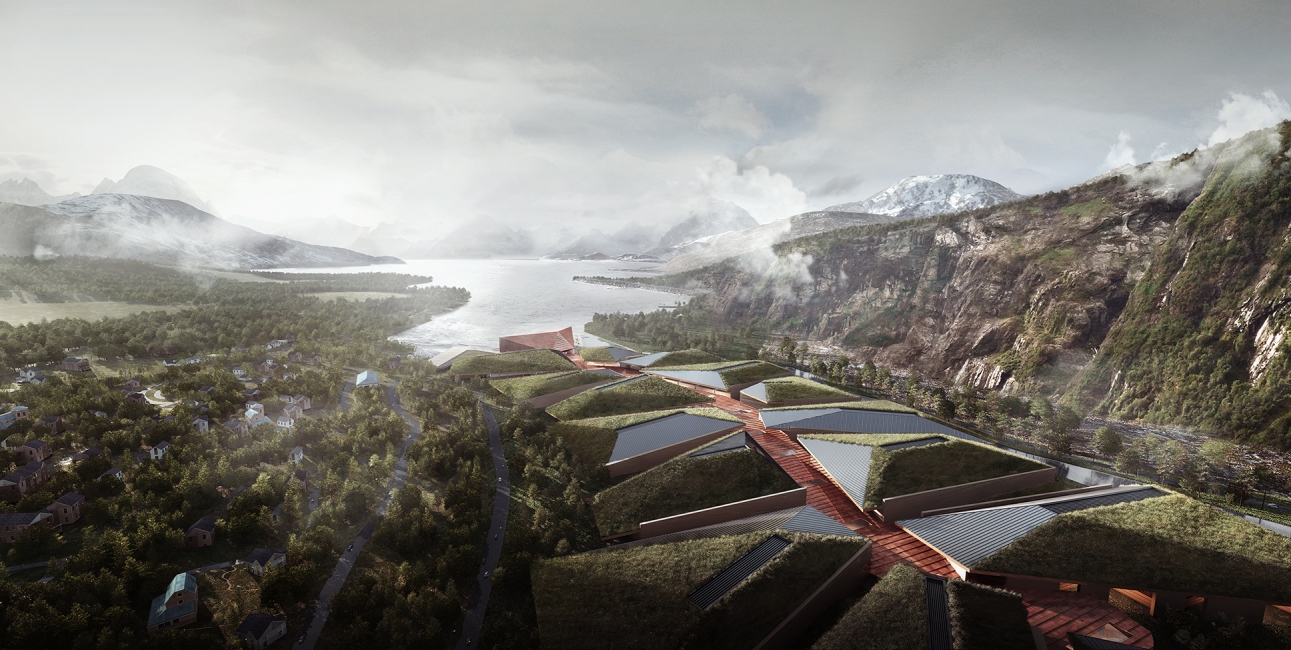
artist’s impression of data center, by Kolos
The suggestion to insert a glacier into Norway recalls Tega Brain, Julian Oliver and Bengt Sjölen’s Asunder (2019), a computer that churns out satellite photo ‘corrections’ to the planet; one of the computer’s solutions to Silicon Valley’s plastic and pollution problem is ‘insert lithium mines.’ The piece is a highlight of The Eternal Network, the festival’s sprawling exhibition. It uses climate modelling software and land-use data to dream up geoengineering solutions to the environmental crisis: Berlin becomes reforested, Shenzhen gets relocated to Vienna.
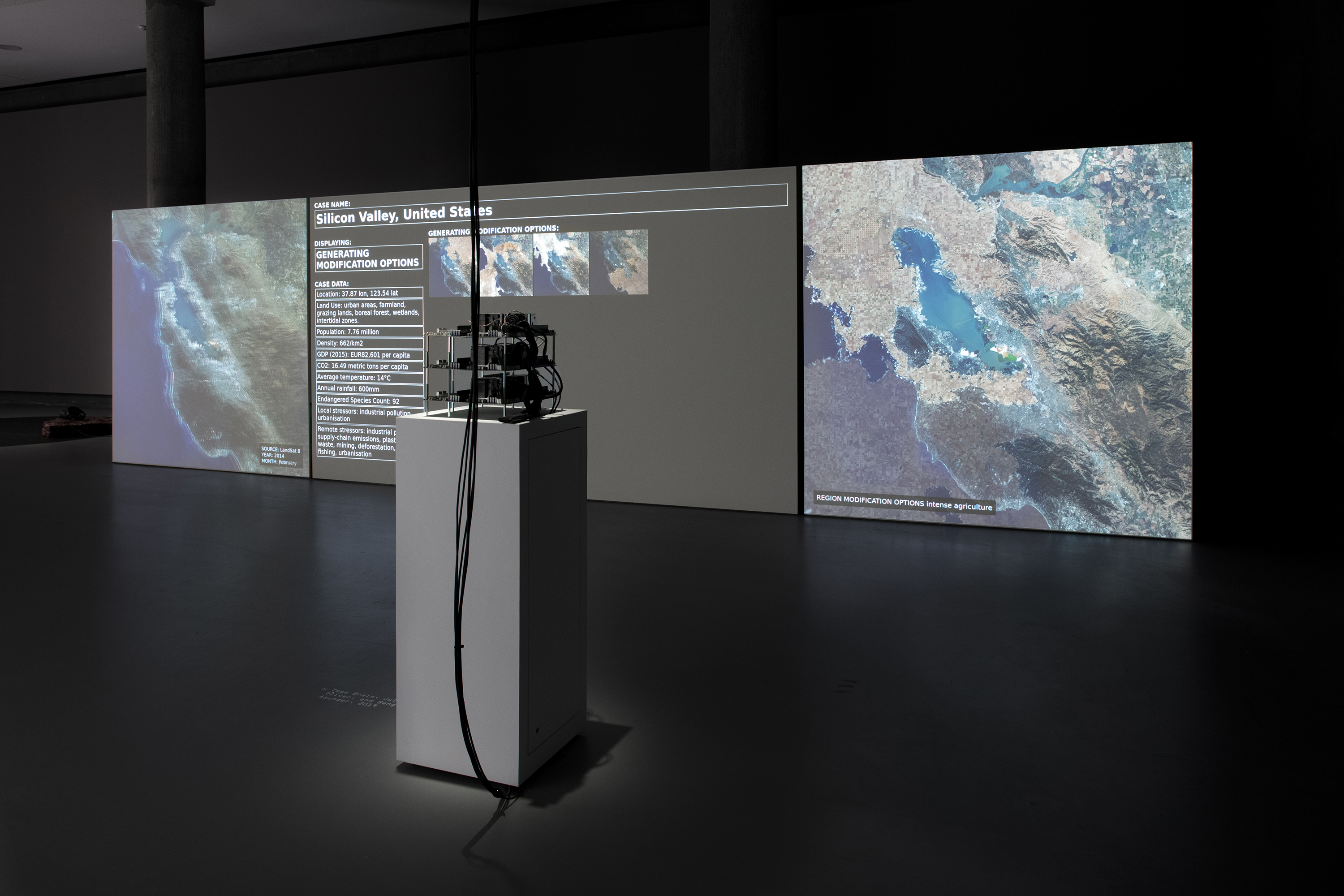
Asunder (2019), Tega Brain, Julian Oliver and Bengt Sjölen. Photo by Luca Girardini
Despite the sober aesthetic and gravitas of the whirring computer equipment on show, the suggestions are absurd, knowingly so. But then so is the way that tech-bros throw glacier-melting AI at the future to figure it out for us. Let’s also remember the 1977 General Assembly move to forbid the ‘deliberate manipulation of natural processes — the dynamics, composition, or structure of the earth, including its biota, lithosphere, hydrosphere and atmosphere, or outer space,” more a global advertisement of what’s possible than legislation to stop it. Asunder is a funny and urgent recognition of how reducing the planet to a dataset abstracts the earth, delegating the job of saving it to machines that don’t particularly care or comprehend for the geographies we make and depend upon.
With the world’s end slowly dawning on Silicon Valley (kind of, at least in press releases), artist Luiza Prado and cultural and media theorist Nelly Y. Pinkrah offered a reminder that we already live in and amongst the ruins of others, and that endings are already well underway throughout much of the global south. Speaking in Next to Devastation, one of the symposium’s two-hour exchanges, Prado referenced the black rain that fell over Rio de Janeiro as the 2019 fires burned: “In indigenous cosmologies, there is a constant struggle to maintain life, to maintain the conditions for life to thrive… When we see that the sky is falling, our role is to look up, and put our arms up, and hold it together.” The question, perhaps, is not when the world will end, but what worlds, and to what lengths we will go to salvage them.
Pinkrah called out the discourse around the anthropocene as an “ongoing act of ignorance towards specific geographies and groups of people that still seem to be not human enough to be considered in certain processes and realities,” weaving in Kathryn Yusoff’s claim that “The Anthropocene as a politically infused geology and scientific/popular discourse is just now noticing the extinction it has chosen to continually overlook in the making of its modernity and freedom.”
Can these freedoms be distributed, and can modernity be reinvested back into collective healing? One strategy theorist Ulises Ali Mejias proposes is ‘paranodality,’ moving out to the peripheries of a network to disimagine and dismantle its corrupted center. If surveillance capitalism follows the logic of colonisation (normalised through strategy games marketed to kids (Age of Empires is settler colonialism, SimCity is socialism, there I said it)), then there are valuable lessons to be learned from the activists and organisers who resisted colonisation: primarily, indigenous and slave-descendant populations in the new world, and people across the global south. We can learn from these — without equating settler colonialism with surveillance capitalism, something that leaders in the field appear to do, notably through phrases like ‘Data Colonialism’ that continue to gather currency. While surveillance and data extraction are indeed methods of managing our access to time and space (and our freedom to act within what time and space we have), the scales of devastation are large enough that any attempt to map the insidious violence of surveillance capitalism onto the violence of historic colonialisms perhaps becomes, at a point, redundant.
But it is within this project of reclaiming our collective time and space that Transmediale gets hopeful, offering methods of navigating ways out of the extractive, financialised climates that are flourishing on and offline. The suggestions for a kind of internet that might produce a world we want to (or even just can) live with come from many directions. There’s no one right answer, and that’s okay: it will take many different strategies to grow through the ruins. One of them is the Fediverse, the decentralised galaxy of the internet, As Made Famous By Mastodon. This sprawling, distributed network of servers acts as an alternative constellation of popular social media platforms, all ran on open source software maintained and moderated by the communities that inhabit them. Recognising that the much-evangelised ‘openness’ of the internet has just cleared the way for data extractivism, the Fediverse seeks to make spaces of kinship that are at once private and public. As Roel Abbing and Aymeric Mansoux put it, care is baked into its community-moderated collectivism, and privacy becomes once again a social problem, not a technical one.
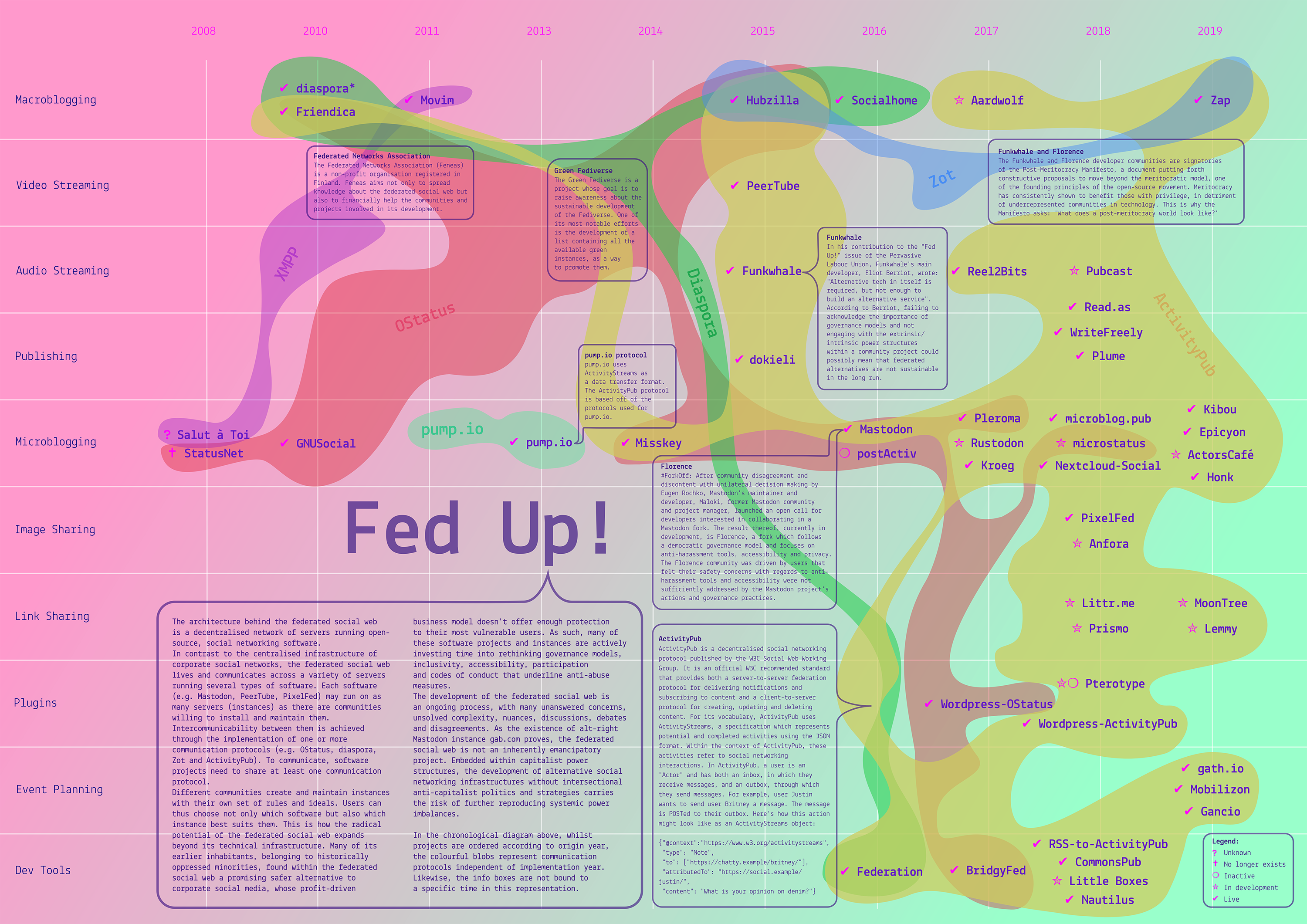
Fed Up!, contribution to Pervasive Labor Union Zine, developed by Lidia Pereira, Artemis Gryllaki and Bohye Woo. Large version here.
Another alternative to the commercial web offered: data co-operatives and the Data Workers Union, movements that seek to recognise our role as workers in an economy that alienates us from the value of our labor even in in the form of information. Their strategies to accomplish this are still a little unclear, but it’s an interesting means to rethink our relationship with the byproducts of our closeness, and how we can organise for ownership over our data.
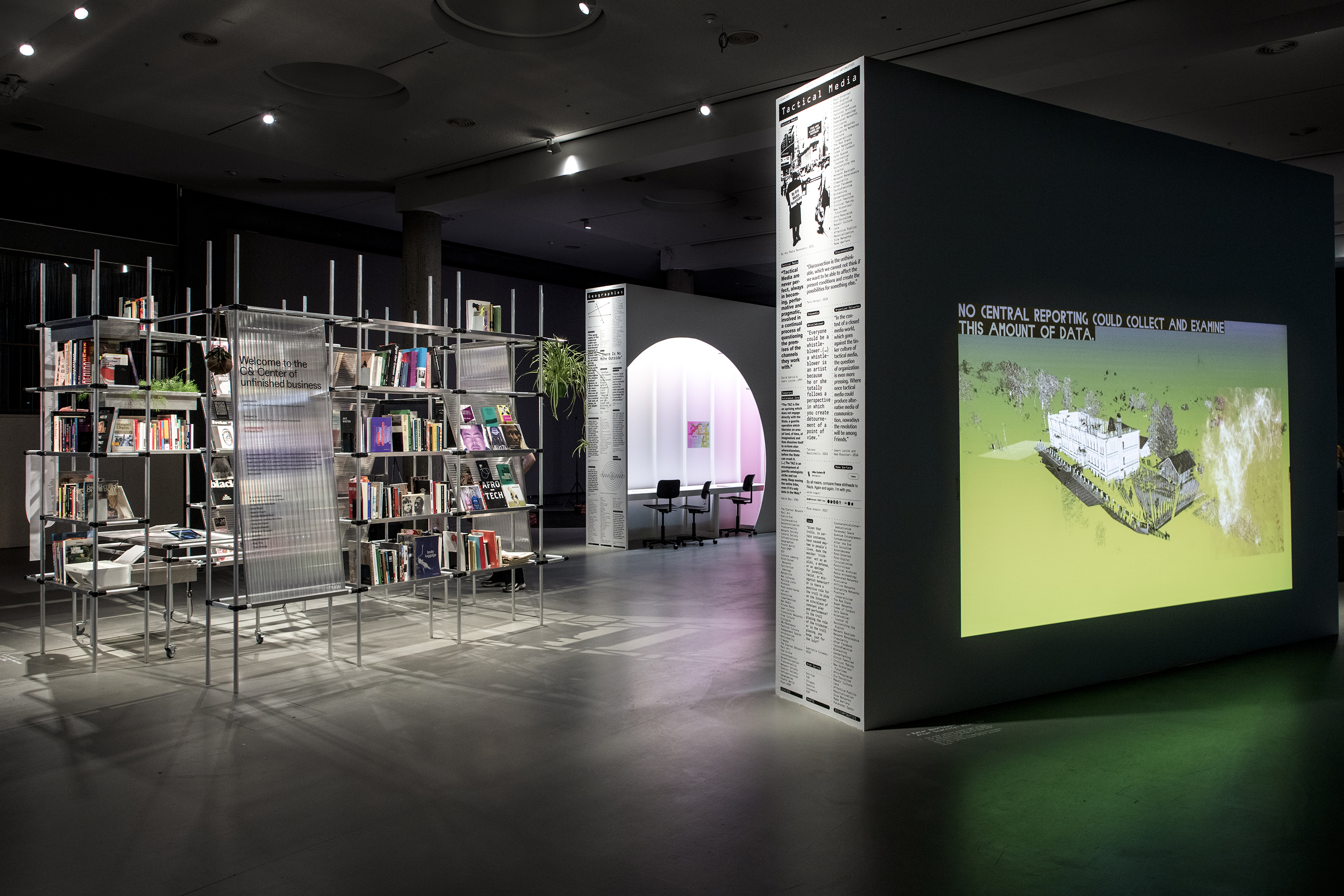
Image: Center for Unfinished Business, since 2016. Photo by Luca Girardi.
Another model for the internet is C&’s Center for Unfinished Business, a metal scaffolding piled with texts, post-it notes, printers, and plants. It’s at the center of the exhibition, and its busy, with people reading, leaving and finding notes, talking. Co-produced with students as a response to the festival’s central question, the travelling activated library presents texts and ideas through which to identify and disassemble the “structures and blind spots of colonial power relations”, a “collective filtering”. Alongside books overtly about colonialism, the library includes historical texts with glaring omissions or denials, left to be annotated and modified by the community. It acts as the potting soil for a networked, collective enquiry; a hyperlinked free library dedicated to investigating, educating and strategising.
When I think about the rate at which things are falling apart, I get overwhelmed. But one thing that lifts me is Jackie Wang’s definition of prophecy: not a way to see the future, but the ability to see the gaps in the present as opportunity. The ruins can’t be knitted back together. Perhaps, though, they can form a scaffolding that we grow through and over. Not a netstalgia, but a germinetting — a network with the emphasis on work. There is much to do.
Transmediale took place in Berlin from 28 January to 1 March 2020. Many of the talks are available to listen to online.
